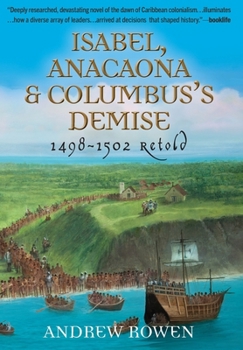Isabel, Anacaona & Columbus's Demise: 1498-1502 Retold
A historical novel, Isabel, Anacaona & Columbus's Demise: 1498-1502 Retold dramatizes from both Native and European perspectives the European subjugation of Espa ola's indigenous peoples during the least studied period of the island's brutal conquest. Based on primary sources, it strikingly sets a Native and European queen-the Ta no Anacaona and Spain's Isabel-on comparable pedestals and tells Columbus's demise through his eyes and those of Ta no chieftains and Spaniards who opposed him.
Queen Isabel and King Fernando struggle to bring their conquest of Espa ola to profitability and order, and she sincerely seeks to curtail her conquerors' enslavement of "Indians" and other abuses, including freeing Indians whom Columbus has enslaved. She and Fernando terminate Columbus's governorship of Espa ola, direct his successors to reorder settler-Indian relationships, and dispatch other explorers to claim the mainland. But Isabel's conquerors mostly ignore her instructions regarding the Indians' treatment.
Anacaona and her brother Chief Behecchio strive to prevent Columbus's conquest from extending to their chiefdom of Xaragu , harboring Spaniards rebelling against Columbus in return for protection from him. Anacaona rises to chieftain on Behecchio's death, outlasting Columbus's governorship and that of his successor and the reigns of nearly all Espa ola's other supreme chieftains. She's determined to preserve Ta no civilization, and her competence as chieftain matches her more renowned allure.
Columbus explores the mainland on his third voyage, recognizes that it's a continent, and then struggles to settle the rebellions against him on Espa ola, ultimately awarding the rebels Indian land and Indians. Scenes closely trace his life, objectives, and activities for two years as governor of Espa ola (while not at sea), often abbreviated in biographies of him. Embittered by opposition, he deteriorates intellectually, collapses, and resists his successor, who investigates his conduct and sends him home in chains.
Scenes also portray daily life at the frontier of conquest, including the inception of mestizo society, the fate of Indians enslaved, the origins of the doctrines of repartimiento and encomienda by which Spain would rule its New World possessions, and the slow advance of Christianity.
The novel is a sequel to, and readable independently from, Encounters Unforeseen: 1492 Retold (2017) and Columbus and Caonab 1493-1498 Retold (2021). A Sources section cites the works considered and sometimes explains the author's reasoning and contrary interpretations. There are thirty-five illustrations and maps, including a sketch of Anacaona.





